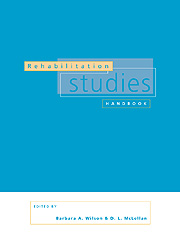Book contents
- Frontmatter
- Contents
- List of contributors
- 1 Introduction to rehabilitation
- 2 Disabled people in society
- 3 Disability equality training
- 4 Towards a therapeutic alliance model of rehabilitation
- 5 Rehabilitation education: a learner-centred approach
- 6 Work, occupation and disability
- 7 Management in rehabilitation
- 8 Research and evaluation in rehabilitation
- 9 Statistical methods
- 10 Social policy, disability and rehabilitation
- 11 Principles of the acquisition of sensorimotor skills
- 12 Management of acquired cognitive disorders
- 13 Challenging behaviour: helping people with severe brain damage
- 14 Pain
- 15 The multiply handicapped child
- 16 The transition to adult life
- 17 Factors specific to disabled elderly people
- Index
8 - Research and evaluation in rehabilitation
Published online by Cambridge University Press: 06 November 2009
- Frontmatter
- Contents
- List of contributors
- 1 Introduction to rehabilitation
- 2 Disabled people in society
- 3 Disability equality training
- 4 Towards a therapeutic alliance model of rehabilitation
- 5 Rehabilitation education: a learner-centred approach
- 6 Work, occupation and disability
- 7 Management in rehabilitation
- 8 Research and evaluation in rehabilitation
- 9 Statistical methods
- 10 Social policy, disability and rehabilitation
- 11 Principles of the acquisition of sensorimotor skills
- 12 Management of acquired cognitive disorders
- 13 Challenging behaviour: helping people with severe brain damage
- 14 Pain
- 15 The multiply handicapped child
- 16 The transition to adult life
- 17 Factors specific to disabled elderly people
- Index
Summary
Introduction
For the worker in the field of rehabilitation the similarities between research and evaluation are likely to be of more interest than the differences. While this chapter aims to describe a wide range of research and methodologies, including the kind of grant-supported research that is conducted by academics and professional researchers, it is also written in the belief that the rehabilitation worker can make a difference to the quality of rehabilitation through self-or unit-directed research that is closely aligned to evaluation. The results of such direct research on the part of workers in the field of rehabilitation can lead to measurable improvements in the rehabilitation of patients in their immediate care. I deliberately avoid stating all patients because, owing to limitations imposed by lack of time, finance and sometimes expertise, much self-or unit-directed research will not be generalisable to other patients. Nevertheless, the kind of direct or ‘action’ research to be described in parts of this chapter can make an extremely important contribution to our knowledge, given the current situation in which there is as yet no adequate theory of rehabilitation and not much in the way of well funded, large research studies that are generalisable. Until we have a theory that can inform practice we should welcome any form of research that chips away at ignorance in rehabilitation. It is possible, after all, that any umbrella theory will include a place for action research on the part of professional workers.
Self-or unit-directed research that is closely aligned to evaluation is essential for people working in rehabilitation because it provides feedback on the productivity of their work.
- Type
- Chapter
- Information
- Rehabilitation Studies Handbook , pp. 161 - 188Publisher: Cambridge University PressPrint publication year: 1997
- 3
- Cited by



